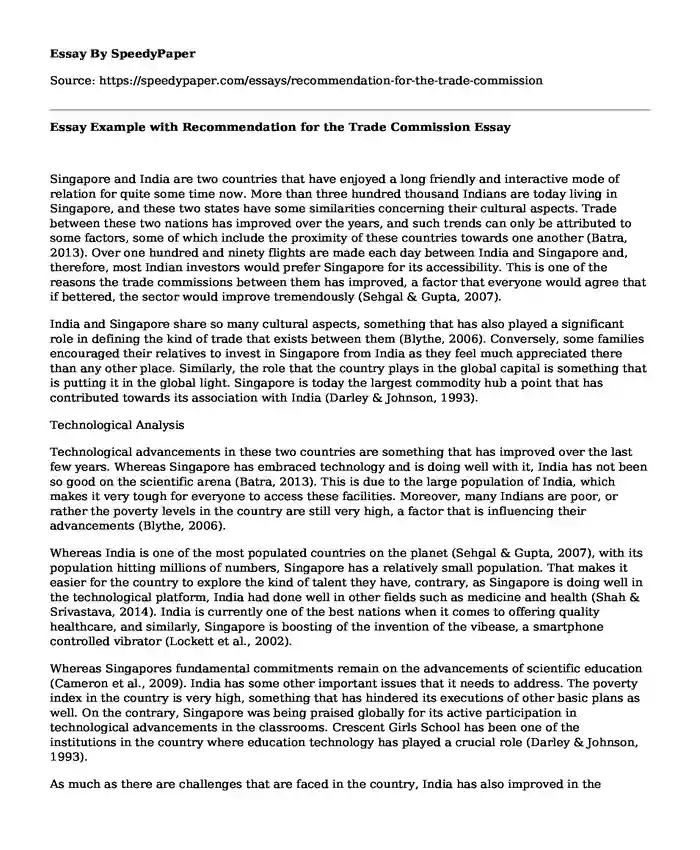
| Type of paper: | Essay |
| Categories: | International relations India |
| Pages: | 3 |
| Wordcount: | 728 words |
Singapore and India are two countries that have enjoyed a long friendly and interactive mode of relation for quite some time now. More than three hundred thousand Indians are today living in Singapore, and these two states have some similarities concerning their cultural aspects. Trade between these two nations has improved over the years, and such trends can only be attributed to some factors, some of which include the proximity of these countries towards one another (Batra, 2013). Over one hundred and ninety flights are made each day between India and Singapore and, therefore, most Indian investors would prefer Singapore for its accessibility. This is one of the reasons the trade commissions between them has improved, a factor that everyone would agree that if bettered, the sector would improve tremendously (Sehgal & Gupta, 2007).
India and Singapore share so many cultural aspects, something that has also played a significant role in defining the kind of trade that exists between them (Blythe, 2006). Conversely, some families encouraged their relatives to invest in Singapore from India as they feel much appreciated there than any other place. Similarly, the role that the country plays in the global capital is something that is putting it in the global light. Singapore is today the largest commodity hub a point that has contributed towards its association with India (Darley & Johnson, 1993).
Technological Analysis
Technological advancements in these two countries are something that has improved over the last few years. Whereas Singapore has embraced technology and is doing well with it, India has not been so good on the scientific arena (Batra, 2013). This is due to the large population of India, which makes it very tough for everyone to access these facilities. Moreover, many Indians are poor, or rather the poverty levels in the country are still very high, a factor that is influencing their advancements (Blythe, 2006).
Whereas India is one of the most populated countries on the planet (Sehgal & Gupta, 2007), with its population hitting millions of numbers, Singapore has a relatively small population. That makes it easier for the country to explore the kind of talent they have, contrary, as Singapore is doing well in the technological platform, India had done well in other fields such as medicine and health (Shah & Srivastava, 2014). India is currently one of the best nations when it comes to offering quality healthcare, and similarly, Singapore is boosting of the invention of the vibease, a smartphone controlled vibrator (Lockett et al., 2002).
Whereas Singapores fundamental commitments remain on the advancements of scientific education (Cameron et al., 2009). India has some other important issues that it needs to address. The poverty index in the country is very high, something that has hindered its executions of other basic plans as well. On the contrary, Singapore was being praised globally for its active participation in technological advancements in the classrooms. Crescent Girls School has been one of the institutions in the country where education technology has played a crucial role (Darley & Johnson, 1993).
As much as there are challenges that are faced in the country, India has also improved in the technological field in a great deal. Likewise, it is regarded as one of the top five nations when it comes to space explorations, something that the country boasts of as doing well in the field of science and technology.
References
Batra, G. S. (2013). Environment Management and Environmental Disclosures: A Comparison of Corporate Practices across Malaysia, Singapore and India. South Asian Journal of Management, 20(1), 62-96.
Blythe, S. E. (2006). Critique of India's Information Technology Act and Recommendations for Improvement, A. Syracuse Journal of International Law and Commerce, 34, 1.
Cameron, L., Chaudhuri, A., Erkal, N., & Gangadharan, L. (2009). Propensities to engage in and punish corrupt behavior: Experimental evidence from Australia, India, Indonesia and Singapore. Journal of Public Economics, 93(7), 843-851.
Darley, W. K., & Johnson, D. M. (1993). Crossnational comparison of consumer attitudes toward consumerism in four developing countries. Journal of Consumer Affairs, 27(1), 37-54.
Lockett, A., Wright, M., Sapienza, H., & Pruthi, S. (2002). Venture capital investors, valuation and information: a comparative study of the US, Hong Kong, India and Singapore. Venture Capital: An International Journal of Entrepreneurial Finance, 4(3), 237-252.
Sehgal, S., & Gupta, M. (2007). Tests of technical analysis in India. Vision: The Journal of Business Perspective, 11(3), 11-23.
Shah, H. h., & Srivastava, A. a. (2014). Signature Provisions in the Amended Indian Information Technology Act 2000: Legislative Chaos. Common Law World Review, 43(3), 208-230.
Cite this page
Essay Example with Recommendation for the Trade Commission. (2019, Jun 14). Retrieved from https://speedypaper.net/essays/recommendation-for-the-trade-commission
Request Removal
If you are the original author of this essay and no longer wish to have it published on the SpeedyPaper website, please click below to request its removal:
- Free Essay on McDonald's: Policy and Strategy in Global Competition Case Study
- Academic Synthesis: Online Education Essay Sample
- Essay Sample on Theories Influencing Parental Involvement
- Free Essay on How Sex in Marriage Can Increase Spirituality and Belief in God
- Free Essay: How the Performance of a Team Is Influenced by the Transformational Leadership
- Essay Sample on Importance of Business Sustainability
- Free Essay: The Family Structure That My Family Resembled
Popular categories




